Caballero B. (ed.) Encyclopaedia of Food Science, Food Technology and Nutrition. Ten-Volume Set
Подождите немного. Документ загружается.


cabbage-like leaves. This forms a tasty food item
known as ‘millionaire’s salad.’ It is nourishing and
digestible, and is considered to be cooling and diuretic.
Inflorescence
0016 The inflorescence of coconut (Figure 3) is very attract-
ive in appearance and has many medicinal properties.
It is commonly used for decorations, religious func-
tions, and several cultural and traditional rituals. It
forms an ingredient of a large number of traditional
medicinal preparations. Tender inflorescence as such
is used for the preparation of many traditional food
items, which is believed to act like a nutraceutical. It is
tapped as a source of sap and is used for the production
of coconut palm wine, vinegar, jaggery, and arrack.
0017 Coconut palm wine In India and Sri Lanka, coconut
palm wine is known as ‘toddy,’ in Philippines and
Mexico as ‘tuba,’ and in Indonesia as ‘tuwak.’ It is
an alcoholic beverage obtained by the natural fermen-
tation of a sugar-containing juice from coconut palms
and is obtained by tapping the unopened inflores-
cence of the palm. The methods of tapping the coco-
nut palm are very ancient and vary from place to
place (Figure 4). The tapping process can be summar-
ized as follows. When the palm has reached the
normal bearing stage, every leaf axils produce a
spadix or inflorescence. The tapping begins when
the inflorescence is 1 month old. This unopened
flower inflorescence is prepared by slightly bruising
it by gentle tapping with a small round piece of wood
or bone (mallet). To prevent it from opening, the
inflorescence is tightly bound with fiber or coconut
leaves. When the inflorescence is nearly ready to pro-
duce juice, which is about 3 weeks, a length of about
5–8 cm is cut from the end. During the preparation,
Tender bud and leaves:
Delicious and nutritive
Mature leaves:
Feed for elephant and
cattle
Roots:
Beverage and medicine
Trunk:
Juice exudates from trunk
after cutting of it is
nutritious
Tender coconut:
Excellent beverage,
medicinal properties
Coconut pith:
Animal feed
Sprouted coconut:
Edible known as
coconut bread
Mature coconut:
Copra, oil, oil cake,
culinary preparations,
coconut milk,
coconut powder,
coconut honey,
coconut pan,
desiccated coconut,
medicines
fig0002 Figure 2 Coconut palm: the tree of life.
1466 COCONUT PALM
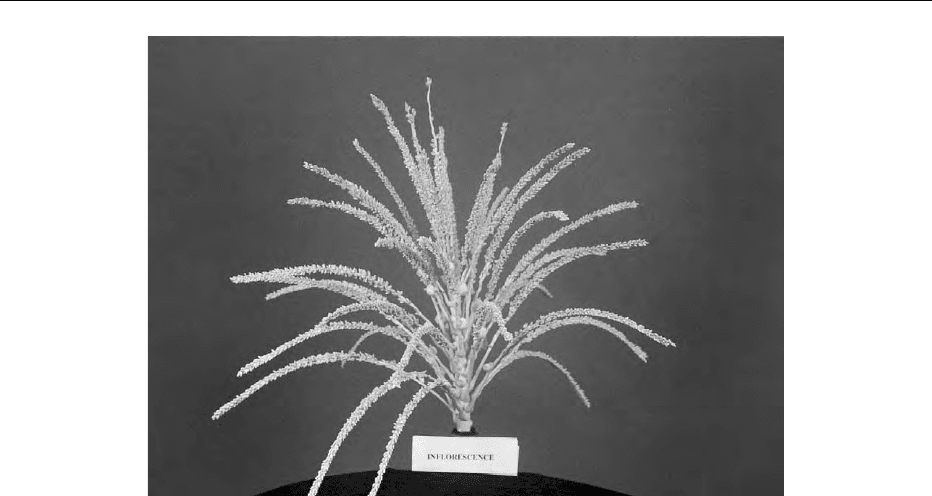
the inflorescence is gradually bent over, so that when
the coconut palm juice flows from the vascular
bundles, an earthen receptacle containing the crust
of microorganisms formed from the previous fermen-
tation is placed for its collection. The flow of juice
increases gradually, and the pot is changed twice
daily, at the same time shaving a thin slice from
the end of the inflorescence, tapping slightly with
the mallet, and smearing on a mixture of bruised
leaves to stimulate the flow of palm wine from the
inflorescence. When the collection of sap is over,
fermentation sets in immediately, and the sap is con-
verted into fresh coconut palm wine or sweet toddy.
This product is a milky white and effervescent liquid
(Figure 4a). Fermentation continues for few more
hours after the sap has been pooled from various
pots. The average yield of toddy per inflorescence
for a tapping period of about 1 month is 18 l. Fresh
coconut palm wine is sweet in taste and is considered
to be a high-energy health drink. It contains a con-
siderable amount of the natural antioxidant ascor-
bic acid, or vitamin C, and the amount of ethyl
alcohol is 2–5% (Table 1). When fermentation
proceeds, the nutritive value of fresh toddy and
concentration of ascorbic acid decrease, while the
concentrations of alcohol and acetic acid increase
(Table 2).
0018 Palm syrup Palm syrup is made by boiling toddy
until it is thick. It can be consumed as a beverage
after dilution with water. It is also a major ingredient
in a number of dairy products.
0019Jaggery Jaggery is a brown solid substance obtained
by boiling sweet toddy up to the crystallization point
(Figure 4a). It is used as a sweetening agent in bakeries
and is also used in the preparation of several food items
and in dairy products. The yield of jaggery from sweet
toddy is about 12–15%. Owing to its flavor, color,
taste, and nutritive value, nowadays, it is used as a
substituteforcanesugarinseveral developedcountries.
0020Fermented coconut palm wine The main ferment-
able carbohydrate in fresh coconut palm wine is su-
crose (12–15%), and a mixture of natural microflora
is used for fermentation. Isolation and culturing of
microflora have revealed the presence of Streptococ-
cus sp., Lactobacillus sp., Acetobacter sp., etc. The
main fermentation products are lactic acid, ethanol,
and acetic acid. The production of lactic acid reduces
the pH from around 7.2 to 5.5 within 8 h. Acetic acid
is produced from ethanol by Acetobacter. The low pH
results in high levels of ethanol, thus providing more
substrate for acetic acid production, and hence pro-
longed standing results in the production of acetic
acid from ethyl alcohol. The concentration of ethyl
alcohol in fermented toddy is 5.2–5.7%.
0021Different types of toddies are marketed, namely,
mineral toddy, ultra toddy, total toddy, oxy toddy,
etc. Techniques have also been developed to can
toddy. The toddy is sterilized and canned immedi-
ately, to preclude any further fermentation and thus
increasing its shelf-life to approximately 8 months.
0022Very few research studies have been conducted on
the effects of ingestion of toddy. Studies on the lipid
fig0003 Figure 3 (see color plate 38) Inflorescence.
COCONUT PALM 1467

and carbohydrate metabolism in female rats fed com-
mercially available toddy in India and its equivalent
quantity of ethyl alcohol during gestation and lacta-
tion have shown that the biochemical alterations
produced in fetuses and pups are different. The non-
ethanolic portion (congeners) of the toddy interferes
with metabolic processes and increases the ethyl
alcohol-induced toxicity.
0023 Toddy yeast Freshly fermented toddy is a favorable
medium for the propagation of baker’s yeast. Hence,
toddy is used as a source of yeast in the bread-baking
industry. Various traditional food preparations like
‘toddy bread’ or ‘kallappam’ (a preparation of rice
paste and toddy after overnight fermentation), ‘vat-
tayappam’ or round bread, etc. are very common in
coconut-growing areas.
0024Coconut vinegar Coconut vinegar (Figure 4a)is
produced throughout South Asia, particularly Sri
Lanka. It is a clear liquid with a strong acetic acid
flavor and a hint of coconut flavor. It is made from
(a)
(b)
fig0004 Figure 4 (a) Toddy tapping. (b) Toddy products.
1468 COCONUT PALM

toddy on a commercial scale. Toddy is stored in acet-
ifying vats, permitting free access to air. Acidification
usually takes about 10–14 days. The alcohol is con-
verted to acetic acid by acetic acid-producing bacteria
(Acetobacter) naturally present in toddy. Vinegar
usually contains 4–5% acetic acid.
0025 Arrack Arrack (Figure 4a) is obtained by distilling
fermented toddy and is common in many countries,
notably in the Philippines and Sri Lanka. It is also
known as coconut fenny in the Indian State of Goa. In
these regions, arrack obtained from toddy is con-
sidered to be superior to the arrack from molasses
and hence is recommended as a potential agent, even
for postnatal care.
Flower
0026 The male and female flowers are separate and are
arranged on the same inflorescence. The spadix of
a mature palm produces on average 300 female
flowers. These flowers are used in many Ayurvedic
preparations. Pollen grains also have medicinal prop-
erties. The flowers are astringent and are used in the
treatment of diabetes, dysentery, leprosy, and urinary
discharges. Opened flowers in the inflorescence pro-
vide a good source of pollen for bees.
Fruit
0027 The fruit is 25 cm or longer in length, ovoid, and
obtusely triangular in cross-section. The tough
fibrous outer husk (mesocarp) encloses a spherical
nut comprising a hard, bony shell (endocarp) within
which is a layer of fleshy meat or kernel (endosperm)
just under 1cm in thickness (Figures 5–7). The kernel
is high in oil and protein when compared with other
oil seed crops. Inside the shell is the liquid endosperm
of coconut or coconut water. If the nut is allowed to
germinate, the cavity of the fruit is filled with a
spongy mass called ‘bread.’ This bread is eaten raw
or toasted in the shell in coconut-growing regions.
Sprouting nuts are also delicious edible items. The
husks and small nuts from a variety of coconut trees
found in the Pacific are also eaten. Religiously, the
fruit plays an important role as an offering to God.
0028Husk Coconut husk is widely used in horticulture,
especially for growing orchids. Experiments have also
proved that coir pith from green fruits can be used as
feed for pigs.
0029Coir pith Coir pith is a waste product obtained
during the process of extraction of coir fiber from
the husk. It is very light, highly compressible, and
highly hygroscopic. It is used as a soil conditioner,
surface mulch/rooting medium and as a desiccant.
Composted coir pith is an excellent organic manure
for indoor plants as well as for horticulture crops.
0030Shell Tarry oil prepared from the shell of the nut is
used externally for the treatment of ringworm. It is
also used to tenderize meat while cooking. It can also
be made into attractive vessels, spoons, flower vases,
etc. In rubber-growing regions, it is used for collecting
latex in plantations. Being a natural product, now-
adays, it is considered to be the best natural alterna-
tive for food packing.
0031Kernel Coconut kernel is consumed in the daily diet
as a culinary ingredient in several parts of the world.
It is either used in the normal state or ground to a
paste. Tender coconut kernel is very delicate and is a
refreshing and high-energy item. Several preparations
with tender coconut kernel are popular in the
coconut-growing areas of the world. Raw coconut
kernel and fried coconut kernel are delicious items
in several parts of the world and are used for several
Ayurvedic preparations.
0032Factors such as the variety of the palm, stages of
maturity of the nut, and conditions of growth deter-
mine the composition of the kernel. The moisture,
protein, and ash content of the kernel decreases as
the nut matures, whereas the fat content increases.
0033Since the coconut kernel contains 40% oil on aver-
age, the general notion is that its consumption could
elevate cholesterol levels. Besides coconut oil, the
tbl0001 Table 1 Composition and specific gravity of fresh coconut
palm wine
Ethanol 2–5 ml per 100 ml
Ascorbic acid 16–30 mg per 100 ml (little change
during fermentation)
Total solids 15.2–19.7 g per 100 ml
Sucrose 12.3–17.4 g per 100 ml
Ash 0.11–0.41 g per 100 ml
Protein (N 6.25) 0.23–0.32 g per 100 ml
Specific gravity at 29
C 1.058–1.077
tbl0002 Table 2 Composition and specific gravity of 12-h-fermented
coconut palm wine
Ethanol 5–5.7%
Acidity (as acetic) 0.32–0.67%
Water 90.3–96.3%
Protein 0.2%
Ether extractives 0.1%
Carbohydrates 1.3%
Mineral matter 0.01%
Calcium <0.01%
Phosphorus 0.01%
Vitamin B
1
<5 IU per 100 ml
Specific gravity at 29
C 0.998–1.033
COCONUT PALM 1469
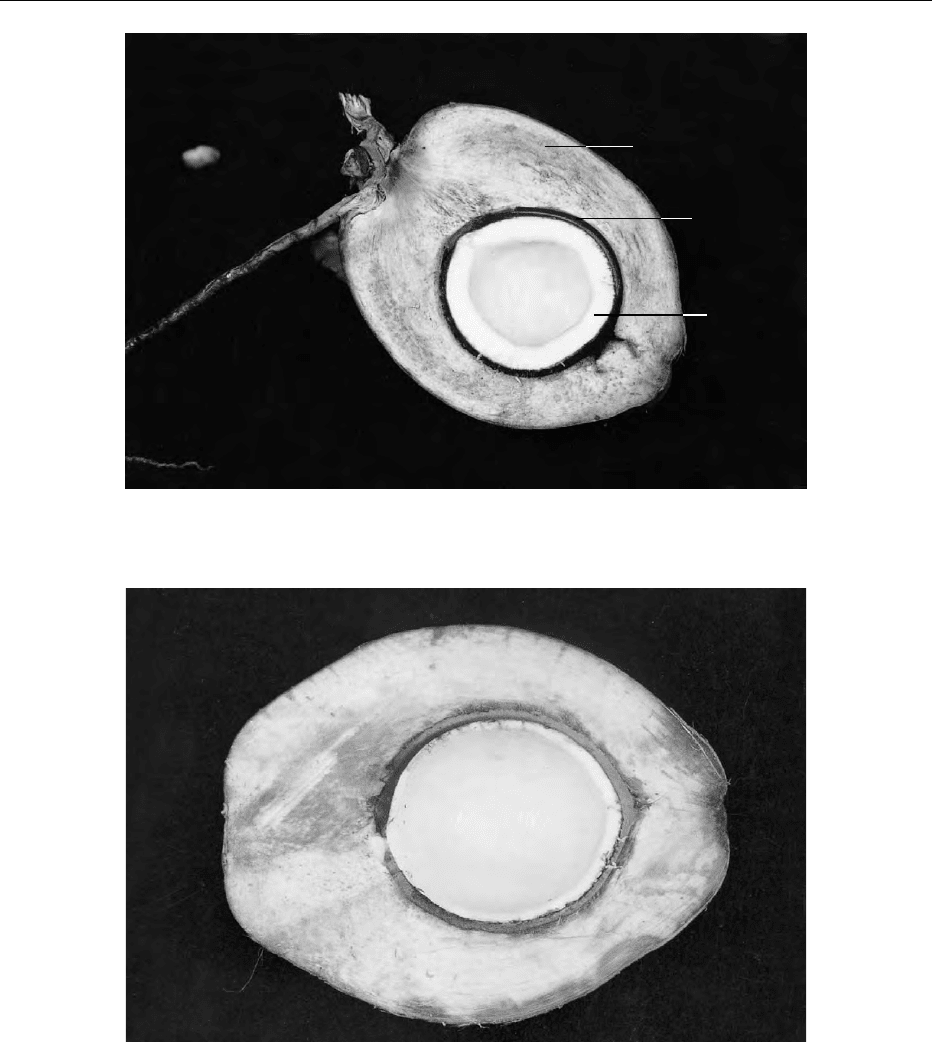
kernel contains 3.6% dietary fiber (Table 3). Re-
search studies undertaken in rats at the University of
Kerala have strongly indicated a significant hypolipi-
demic effect of the neutral detergent fiber isolated
from coconut. This effect is attributed to the presence
of a hemicellulose component. Proteins isolated from
coconut kernel have also been found to have a lipid-
lowering effect in experimental animals. This benefi-
cial effect of the kernel protein is attributed to its very
low lysine/arginine ratio (2.13% lysine and 24.5%
arginine). Recent reports have shown that feeding
coconut kernel along with coconut oil in human vol-
unteers reduced the total serum cholesterol and low-
density lipoprotein-C (LDL-C) when compared with
feeding coconut oil alone. Neutral detergent fiber
extracted from coconut has been shown to decrease
the levels of lipids and lipid peroxides in rats fed a
fat-rich diet.
Mesocarp
Endocarp
Kernel
fig0005 Figure 5 Vertical section: coconut.
fig0006 Figure 6 Vertical section: tender coconut.
1470 COCONUT PALM
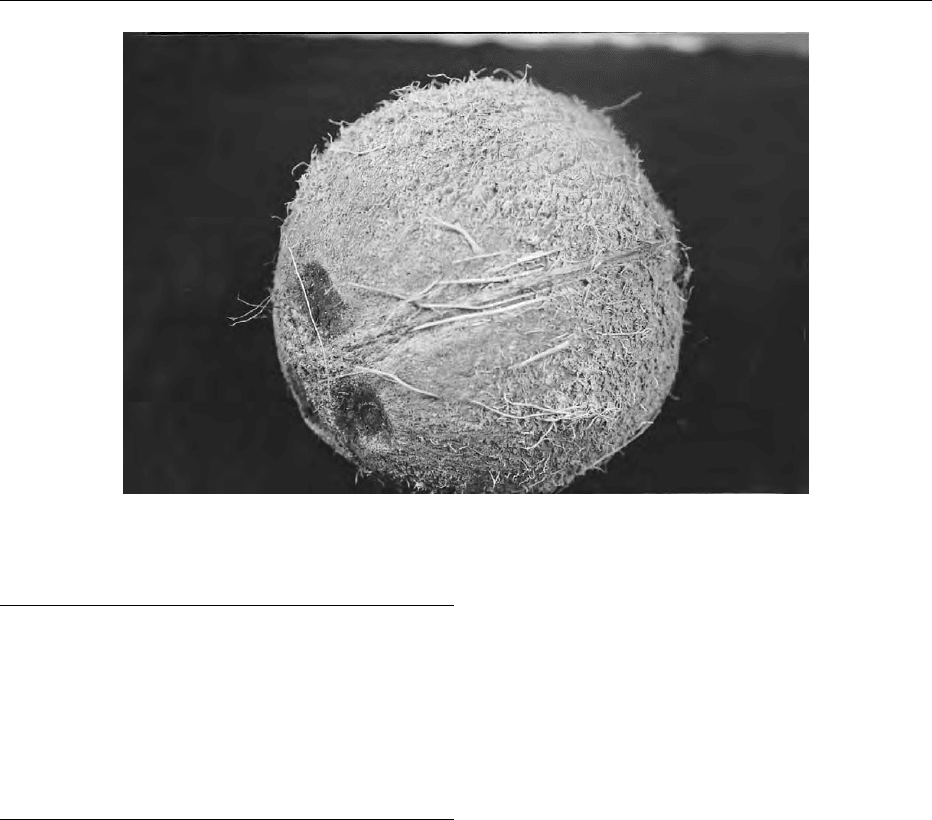
0034 Desiccated coconut Desiccated coconut is the disin-
tegrated and dehydrated coconut kernel or pulp
largely comprising the white portion of the kernel,
after removing the brown testa or parings. It is re-
ferred to as ‘farane de coco’ in France. The process of
preparation involves initial sterilization by washing in
boiling water, followed by disintegrating or shredding
and ultimately by drying at 60–75
C to a moisture
level of less than 2.5%. Desiccated coconut was first
manufactured from imported nuts in England and in
the USA in the early 1880s. It is pure white in color,
crisp, and has a fresh taste. It contains 68–72% oil
and has a nitrogen content of around 1.05%. The
chief protein is globulin, the sugar present is mainly
sucrose (6–7%), and the crude fiber amounts to 4%.
0035 Coconut oil is important in the confectionery and
bakery industry. It is mainly used in biscuits, confec-
tionery, bakery, and other food industries, and also
for household purposes in countries where coconut is
not grown.
0036Byproducts of manufacture of desiccated coconut
(brown testa or parings) The parings, which, under
normal working conditions, amount to 12–15% of
the kernel, are dried and pressed for oil (yield 55%).
Parings oil differs somewhat in composition from
ordinary coconut oil. Its iodine value ranges from
19 to 25, its saponification value ranges from 237 to
244, and its acid value is higher than that of commer-
cial coconut oil. Parings oil is mostly used for soap-
making.
0037Coconut milk Coconut milk is the cold aqueous
extract of coconut kernel (Figure 8) and is used in
cooking. Techniques have been developed to preserve
coconut milk, and so now it is available commer-
cially. Various techniques have also been developed
to manufacture coconut cream and spray-dried coco-
nut milk powder.
0038Coconut milk after bottling can be used as a substi-
tute for cows’ milk. In Philippines, sugar and citric
acid are added to coconut milk to produce coconut
syrup, which is used in the confectionery. Coconut
honey is also prepared from coconut milk after the
addition of jaggery and glucose. This has a nutty
flavor and can be used as a substitute for honey.
0039Copra Dried or dehydrated coconut is called copra
(Figure 8). On average, 1000 nuts will produce about
180 kg of copra. Copra is used as a culinary ingredi-
ent and also for the production of oil. Copra process-
ing is a widespread activity involving dehusking,
splitting the nuts into two equal halves, and sun
tbl0003 Table 3 Composition of fresh coconut kernel
Water 36.3 ml per 100 g
Protein 4.5 g per 100 g
Fat 41.6 g per 100 g
Carbohydrates 13.0 g per 100 g
Fiber 3.6 g per 100 g
Minerals 1.0 g per 100 g
Among the minerals present:
Ca 10 mg per 100 g
P 24 mg per 100 g
Fe 1.7 mg per 100 g
fig0007 Figure 7 Dehusked coconut.
COCONUT PALM 1471
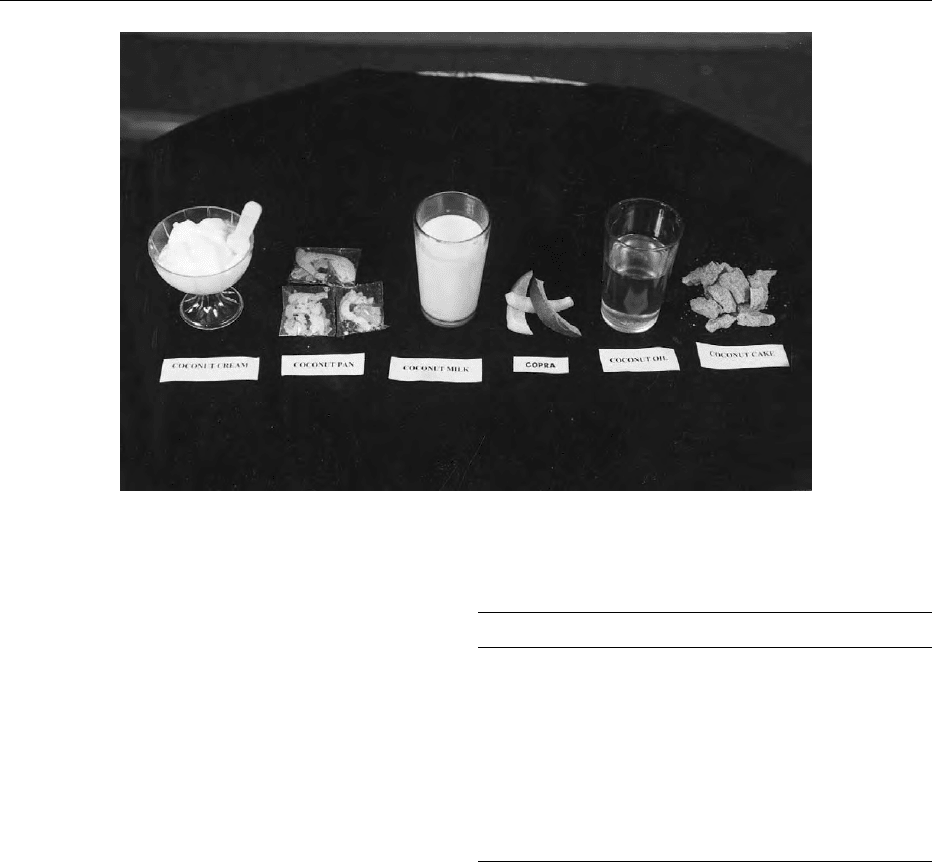
drying. Sun drying takes about 4–7 days, depending
on the sunshine, to dry copra to the desired moisture
level (below 6%). Improved drying methods to
reduce the duration of drying include smoke drying
and hot-air drying. Smoke drying, requiring a drying
time of 36 h, and hot-air drying reduce the contamin-
ation of copra and fungal attack, thus improving the
quality of the oil.
0040 Feeding of copra to pigs and poultry has produced
good results, but it is an expensive animal feed. As the
fat in copra contains only small amounts of unsatur-
ated fatty acids, its consumption leads to firm body
fat and good flavor.
0041 Coconut oil Coconut oil (Figure 8) constitutes the
major commercial product of coconut. Coconut oil is
used as a cooking fat, hair oil, body oil, and industrial
oil. Refined coconut oil is prepared exclusively for
industrial purposes and is widely used in the manu-
facture of biscuits, chocolates, icecreams, margarine,
and confectionery items. It is also used for the manu-
facture of paints and pharmaceutical agents. Desir-
able properties such as a low melting point, resistance
to rancidity, pleasant flavor, and easy digestibility
make it an ideal ingredient in the food industry. Co-
conut oil is a source of many oleo chemicals such as
fatty acids, methyl esters, and fatty alcohol. For
cooking and toiletry purposes, it is commonly used
in the form of filtered coconut oil. Virgin coconut oil,
which is a high-quality oil, is prepared from the milk
extracted from the raw kernel. This type of coconut
oil is most suitable as a massage oil for babies.
0042Coconut oil is a rich source of saturated fatty acids,
and short- and medium-chain fatty acids account
for 70% of these fatty acids (Table 4). It has a
low content of unsaturated fatty acids with a negli-
gible content of both n:6 and n:3 polyunsaturated
fatty acids and a low n:6/n:3 ratio (< 4). The highly
resistant nature of coconut oil to oxidative rancidity
is attributed to its high concentration of saturated fat
and low unsaturated fatty acids. This quality makes it
suitable for storage without deterioration.
0043Copra, which is obtained by drying coconuts, is the
source of coconut oil. Power-driven rotaries and ex-
pellers are used for extracting oil from copra. This oil
extraction is immediately followed by the separation
of cake residue and mucilage by filtering or by
settling.
0044Because of the unique qualities of lauric acid (C:12)
present, coconut oil is widely used in soaps and
tbl0004Table 4 Fatty acid profile of coconut oil
Commonname Fatty acid Percentage
Caproic acid 6:0 0.2–0.5
Caprylic acid 8:0 5.4–9.5
Capric acid 10:0 4.5–9.7
Lauric acid 12:0 44.1–51
Myristic acid 14:0 13.1–18.5
Palmitic acid 16:0 7.5–10.5
Stearic acid 18:0 1.0–3.2
Arachidic acid 20:0 0.2–1.5
Oleic acid 18:1n-9 5.0–8.2
Linoleic acid 18:2n-6 1.0–2.6
fig0008 Figure 8 Coconut products.
1472 COCONUT PALM

cosmetic manufacturing industries. Lauric acid is
known to possess antiviral, antibacterial, and anti-
protozoal qualities. It is converted to the monoglycer-
ide monolaurin in the human or animal body.
Monolaurin is antiviral, antibacterial, and antiproto-
zoal. Reports indicate that monolaurin is capable of
destroying lipid-coated viruses such as HIV, herpes,
cytomegalovirus, influenza, various pathological bac-
teria, including Listeria monocytogenes and Helico-
bactor pylori, and protozoa such as Giardia lamblia.
It is synthesized in babies from the lauric acid of
mother’s milk. Capric acid, another fatty acid found
in coconut, also has antimicrobial activities.
0045 Tocopherols are the natural antioxidants present
in coconut oil. The volatile flavor constituent of
crude coconut oil includes ketones, lactones and d-
lactones of which dL
8
to dC
10
with undecan-2-1 as
the major component at 290 p.p.m. and d-decalac-
tone as the major lactone component at 97 p.p.m.
The flavor and aroma of coconut oil are attributed
to d-octalactone. Ketones are derived from the micro-
biological dissociation of fatty acids. The digestibility
coefficient of coconut oil is higher (with 91.0% as-
similable glycerides) than any other fat, including
butter, and so it is digested more rapidly than any
other fats. This easy digestibility makes it an essential
ingredient for many ghee substitutes.
0046 The consumption of saturated oil could hasten the
onset of cardiac problems, as suggested by certain
research studies. Coconut oil, being a saturated oil,
caused concern that adversely affected the prospects
of the coconut industry. The major fatty acids of
coconut oil are medium-chain fatty acids. A shorter
chain length allows fatty acids to be metabolized
without the use of a carnitine transport system.
Since the short- and medium-chain fatty acids can
be rapidly oxidized, they are less conducive to fat
deposits compared with long-chain fatty acids. Early
studies conducted in experimental animals fed a syn-
thetic diet containing coconut oil as the source of fat
have shown it to be atherogenic, since it is deficient in
essential fatty acids. Essential fatty acid deficiency is
known to facilitate the development of atheroscler-
osis. But under normal conditions, the possibility of
essential fatty acid deficiency as such is quite remote,
since their presence in other food items will offset any
deficiency in coconut oil. Thus, the increase in lipo-
genesis observed in earlier studies was due to the
faulty design of the experiments. Feeding coconut
oil at normal levels along with other fats adequately
supplemented with linoleic acid renders coconut oil
neutral in terms of atherogenecity. Epidemiological
studies also support this. The University of Kerala
conducted a study in 64 volunteers and found no
statistically significant alterations in the serum total
cholesterol, high-density lipoprotein (HDL) choles-
terol, LDL cholesterol, HDL-C/total cholesterol
ratio, LDL-C/total cholesterol ratio, and triglycerides
from the baseline values. Feeding coconut oil results
in an increase in HDL cholesterol.
0047Recent studies have shown that the presence of
natural coconut fat in the diet leads to a normaliza-
tion of body lipids, protects alcohol damage to the
liver, and improves the immune system’s antiinflam-
matory response.
0048Coconut oil is needed for the good absorption of
fat and calcium from infant formulas. Hence, it has
been recommended in infant formulas.
Coconut Cake
0049This is the residue left after the extraction of oil from
copra and is widely used as cattle feed (Figure 8). The
residual oil in the cake can be extracted by the process
of solvent extraction, and the resulting defatted cake,
containing less than 1% oil, is used in cattle-feed
manufacture. The extracted residual oil is largely
used for industrial purposes.
0050Uses of coconut cake Coconut cake, which is com-
monly used as a cattle and poultry feed, is soaked in
water prior to feeding. Since it imparts a firm texture
to butter and provides harder body fat, it is useful for
dairy and fattening cattle, respectively. Field and la-
boratory investigations have shown that coconut
cake can be used as a fertilizer (Table 5). Coconut
cake is rather rich in fiber, and hence, its inclusion in
pig diets is restricted. The maximum safe quantity of
coconut cake with dairy cows is 1.5– 2 kg daily; feed-
ing larger quantities may result in tallowy butter. Beef
cattle can consume much more without any impair-
ment in carcass quality.
0051Coconut flour This is essentially coconut cake in a
more attractive and edible form. It is prepared by
extracting oil from desiccated coconut, drying, and
grinding the residue to a suitable degree of fitness. Its
tbl0005Table 5 Composition of coconut cake after removing oil by the
expeller method and solvent-extraction method
Composition Methodofextraction
Expeller (%) Solvent extraction (%)
Moisture 7.0 8.9
Fat 6.7 2.4
Protein 21.2 21.4
(N 6.25)
Nitrogen-free 47.4 47.4
Extract
Fiber 11.2 13.3
Mineral matter 6.5 6.6
COCONUT PALM 1473
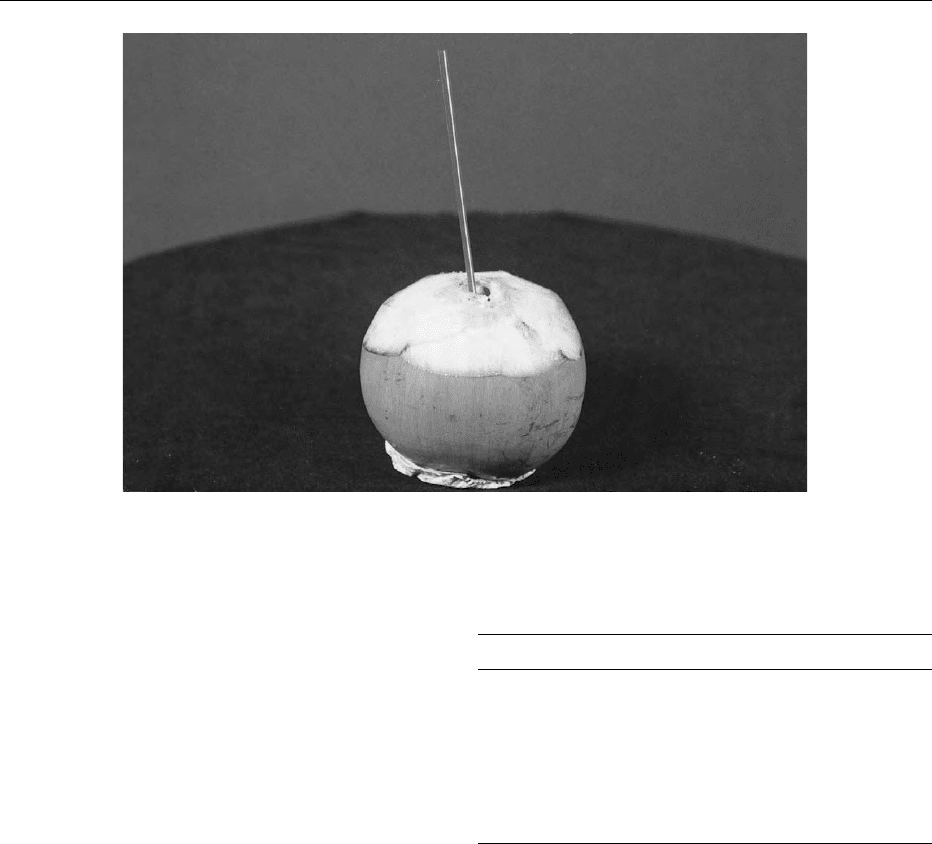
keeping qualities are not good, and it may be expen-
sive.
0052 Coconut water This is the liquid endosperm of coco-
nut (Figure 9). The composition of coconut water
changes during the course of ripening of the fruits
and in germination. The concentration of total solids
during the initial days is about 2.5 g per 100 ml. This
increases gradually as the nut ripens, reaches a max-
imum of about 6 g per 100 ml at about the seventh
month, and then declines. During germination, water
completely disappears.
0053 Sugars are the most important constituent. During
the early days, only inverted sugars are present, and
their concentration in the coconut water increases to
a maximum by the fifth and sixth month. Thereafter,
the level of sucrose rises, though the concentration of
the total sugars declines rapidly, until its content
reaches 2 g per 100 ml approximately.
0054 Tender coconut water is commonly consumed as a
beverage. It is enriched with various minerals such as
potassium, phosphorus, magnesium, sulfur, chlorine,
sodium, calcium, copper, iron, etc. Various proteins
and amino acids such as arginine, cystine, alanine,
etc. and the B vitamins are also present. Moreover, it
is recommended as a useful alternative to glucose
saline in cases of gastroenteritis and urinary diseases.
It has a caloric value of 0.073 kJ per 100 g, potassium
constitutes the principal inorganic constituent, and
malic acid is the predominant organic acid (Table 6).
0055 Experimental studies have indicated the presence
of certain unidentified substances or combination of
substances in coconut water that are capable of indu-
cing rapid proliferative changes in plant tissues. Nate-
de-coco is a gelatinous delicacy formed by the action
of the microorganism Acetobactor xylinium in the
culture medium of coconut water. Coconut water is
also an excellent medium for the production of pro-
tein foods using a culture of the food yeast Sacchar-
omyces fragilis.
0056A patent granted by the UK to the FAO involving a
new technology permits manufacturers to bottle bio-
logically pure and tasty coconut water that is rich in
salts, sugars, and vitamins, as used by athletics. This
technology employs a cold sterilization processing
method that prevents the loss of flavor and other
nutritional characteristics. It is also used in medicinal
preparations. In the Ayurvedic ointment ‘ilaneer-
kuzhmbu’ (from the Sanskrit terms ‘ilaneer,’ meaning
tender coconut water, and ‘kuzhambu,’ meaning
fig0009 Figure 9 Tender coconut.
tbl0006Table 6 Composition of ascorbic acid and B vitamins in
coconut water
Vitamin Amount
Ascorbic acid 2.2–3.7 mg per 100 ml
Nicotinic acid 0.64 mgml
1
Pantothenic acid 0.52 mgml
1
Biotin 0.02 mgml
1
Riboflavin <0.01 mgml
1
Folic acid 0.003 mgml
1
Thiamine Trace
Pyridoxine Trace
1474 COCONUT PALM

paste) for the eye, coconut water is used as the princi-
pal ingredient.
0057 Coconut water increases the blood circulation in
the kidneys and causes profuse diuresis. It is also a
urinary antiseptic and eliminates poisons through the
kidneys in case of mineral poisoning.
0058 Coconut water vinegar Despite its low sugar con-
tent, coconut water is considered to be a good base
for vinegar. For this, coconut water is allowed to
ferment for 7 days after adding sugar, as a result of
which sugar is converted to alcohol.
Heart of the Palm
0059 In some places, the heart of the palm is used raw or
boiled for use in salads.
See also: Alcohol: Properties and Determination; Amino
Acids: Properties and Occurrence; Antioxidants:
Synthetic Antioxidants; Biotin: Properties and
Determination; Fats: Digestion, Absorption, and
Transport; Fatty Acids: Dietary Importance; HIV Disease
and Nutrition; Protein: Food Sources; Sugar Alcohols;
Wines: Production of Table Wines; Yeasts
Further Reading
Child R (1974) Coconut, Tropical Agriculture Series.
London: Longman.
Nair MK, Khan HH, Gopalasundaram P and Rao EVVB
(1993) Advances in Coconut Research and Develop-
ment. Oxford: Oxford & IBH Publishing.
Parsley GJ (1992) Replanting the Tree of Life: Towards an
International Agenda for Coconut Palm Research. Wall-
ingford, UK: CAB International.
Silas EG, Aravindakshan M and Jose AI (1991) Coconut
Breeding and Management. Vellanikkara, India: Kerala
Agricultural University.
Thampan PK (1981) Handbook on Coconut Palm, 3rd edn.
Oxford: Oxford and IBH Publishing.
Cod See Fish: Introduction; Catching and Handling; Fish as Food; Demersal Species of Temperate Climates;
Pelagic Species of Temperate Climates; Tuna and Tuna-like Fish of Tropical Climates; Pelagic Species of Tropical
Climates; Demersal Species of Tropical Climates; Important Elasmobranch Species; Processing; Miscellaneous
Fish Products; Spoilage of Seafood; Dietary Importance of Fish and Shellfish; Fish Farming; Fish Meal
Codex See Legislation: History; International Standards; Additives; Contaminants and Adulterants; Codex
COENZYMES
J H Freeland-Graves, University of Texas at Austin,
Austin, TX, USA
C Bavik, University of Sheffield, Sheffield, South
Yorkshire, UK
Copyright 2003, Elsevier Science Ltd. All Rights Reserved.
Background
0001 Life as we know it is made possible by enzymes,
highly specific proteins that facilitate biochemical
reactions. The term holoenzyme refers to an active
enzyme complex. An apoenzyme is the protein por-
tion of the active unit. The term prosthetic group is
used to refer to minerals, activated vitamins or other
nonprotein compounds that are required for full
enzyme activity. Cofactors are nonprotein sub-
stances, typically mineral ions and activated vitamins
that are required for the function of certain enzymes
and other regulatory proteins. Some cofactors are
essential at the active site of a reaction, while others
help maintain the structural integrity of an enzyme
or protein. Coenzymes are activated vitamins that
participate in reactions with a stoichiometry equal
to substrate. (See Enzymes: Functions and Char-
acteristics.)
0002An overview of how vitamins and minerals
participate as cofactors in the overall processes of
COENZYMES 1475
